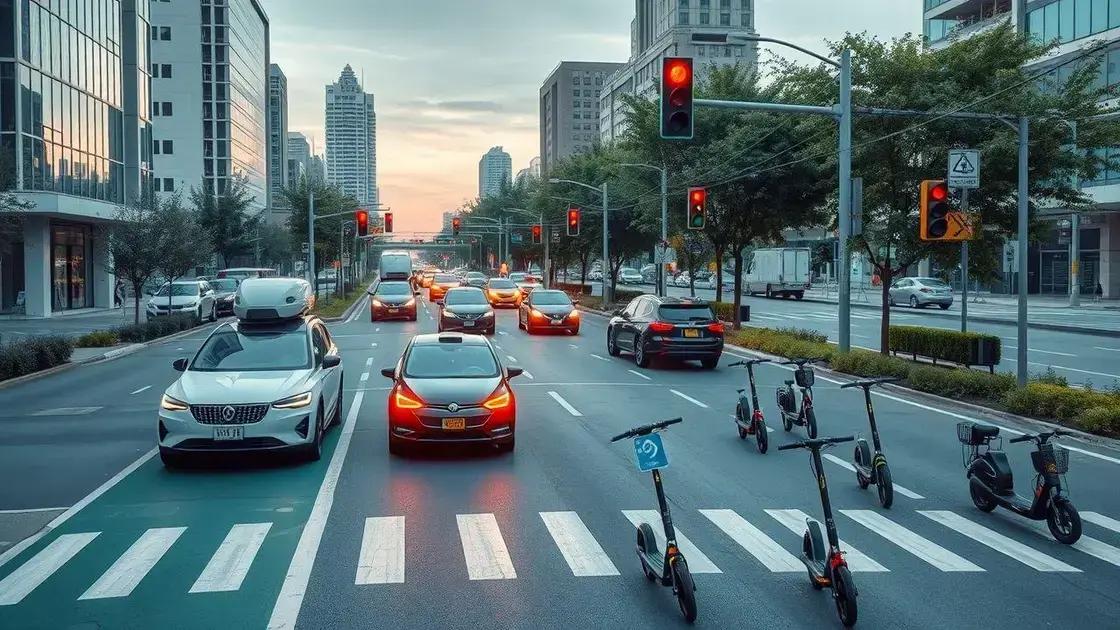Smart grid integration for electric public transit systems

Smart grid integration for electric public transit enhances efficiency, reduces operational costs, and improves service reliability while facilitating the transition to sustainable, eco-friendly transportation systems in urban areas.
Incorporating smart grid integration for electric public transit is a game-changer for urban transportation. Have you ever wondered how these systems can improve efficiency and reduce costs? Let’s dive into how this technology is reshaping public transit.
Understanding smart grid technology
Understanding smart grid technology is essential for improving electric public transit systems. Smart grids are modern electrical grids that use digital communication technology. This allows for two-way communication between utilities and consumers, optimizing energy use and promoting efficiency.
The idea behind smart grid technology is to enhance the existing power grid. By incorporating real-time data, it can adjust energy distribution based on demand. This means less wasted energy and reduced costs for transit systems. With the increasing use of electric buses, this technology is more vital than ever.
Key Features of Smart Grids
Smart grids offer several features that significantly benefit public transit:
- Real-time monitoring: Utilities can track energy flow and consumption patterns.
- Advanced metering infrastructure: This technology helps in collecting data automatically and accurately.
- Demand response capabilities: Adjusting supply based on demand to prevent overloads during peak times.
- Integration with renewable energy: Smart grids support solar and wind energy, providing greener options.
Overall, the availability of smart grid technology allows cities to manage their energy resources more effectively. This has massive implications for electric public transit. When buses can charge at times of lower demand, energy costs drop significantly.
Furthermore, this integration helps in reducing greenhouse gas emissions. As cities move toward sustainability, smart grids are key in achieving those objectives. They facilitate an interaction between electric vehicles and the grid, encouraging efficient charging practices.
Challenges in Smart Grid Implementation
While the benefits are clear, there are challenges to consider. Installing new infrastructure, for instance, can be costly and time-consuming. Cities must balance the immediate costs with long-term savings and efficiency gains. Training staff and supporting users in adapting to new technologies is also critical.
With the right approach, smart grid integration can lead to a more sustainable and efficient public transit system. These systems play an integral role in modernizing urban transportation, laying the groundwork for a greener future.
Benefits of integrating smart grids in public transit

The benefits of integrating smart grids in public transit are numerous and significant. By merging smart grid technology with public transportation systems, cities can achieve greater efficiency and sustainability.
One major benefit is the reduction in operational costs. With real-time data, transit agencies can manage energy consumption more effectively. Charging electric buses during off-peak hours can lead to substantial savings. This type of energy management also helps to avoid grid overload during peak demand times.
Enhanced Reliability
Another advantage is improved reliability for users. Smart grids allow for better scheduling and coordination of services. This means fewer delays and more consistent public transportation options. Passengers can have access to real-time updates about their bus’s arrival, making commuting more convenient.
- Increased efficiency: Smart grids facilitate optimized routes and schedules.
- Improved service quality: Passengers benefit from less wait time and more frequent service.
- Environmental sustainability: The use of cleaner energy sources contributes to lower emissions.
- Integration with renewable energy: Solar and wind energy can be harnessed to power transit systems.
Moreover, the integration of smart grids supports cities in their sustainability goals. As urban populations grow, the demand for cleaner transit options increases. Smart grids help to facilitate this transition by enabling the use of renewable energy sources. This not only reduces carbon footprints but also promotes a healthier urban environment.
By adopting smart grid technology, public transit systems can also enhance the passenger experience. Passengers can enjoy improved access to information and services. The result is a more engaging and user-friendly experience, encouraging more people to choose public transit over personal vehicles.
Community Impact
Integrating smart grids can also provide significant benefits to the community. By creating jobs in technology and infrastructure, cities stimulate their local economies. Furthermore, public transit powered by smart grids can lead to better air quality. This is crucial for public health and community well-being.
Ultimately, the benefits of integrating smart grids in public transit extend far beyond efficiency. They represent a key step toward modernizing urban transport systems and ensuring a sustainable future.
Challenges faced by cities in implementation
Challenges faced by cities in the implementation of smart grid technology for public transit are significant and can impede progress. Transitioning to a modern energy infrastructure is not simple. Many cities encounter hurdles that can slow down or complicate the integration process.
One of the foremost challenges is the high initial cost associated with upgrading existing infrastructure. Cities often operate with tight budgets, making it difficult to allocate funds for new technology. These investments, while beneficial in the long run, require substantial upfront capital that may not be available.
Technical and Operational Challenges
Beyond financial constraints, cities also face technical and operational challenges. Implementing smart grids requires specialized knowledge and technical expertise. Training existing staff to manage new systems can take time and resources. Additionally, cities may struggle with system compatibility between old and new technologies, complicating the installation process.
- Data management: Handling the vast amounts of data generated by smart grids can be overwhelming without proper systems in place.
- Cybersecurity: Protecting the grid from cyber threats and attacks is vital, but many cities feel underprepared.
- Public acceptance: Gaining community buy-in for new technologies can be challenging, especially if residents are not well-informed.
- Regulatory hurdles: Navigating government regulations and policies can slow down the implementation process.
Moreover, engaging the public and ensuring they support smart grid initiatives can pose a significant challenge. As cities introduce these transformative systems, they need to communicate their benefits clearly and effectively. If citizens do not see the value, they may resist these changes, which can stall progress.
The issue of interoperability is another crucial factor. Cities must ensure that new systems can work seamlessly with the existing ones. Incompatibility can lead to inefficiencies and increased costs, defeating the purpose of the upgrade. Addressing these challenges requires careful planning and collaboration among city officials, tech developers, and community stakeholders.
Future Considerations
Successful implementation of smart grids in public transit demands ongoing assessment and adaptation. Cities must remain agile, adjusting their strategies as technology evolves and community needs change. Building partnerships with private companies and non-profits can also provide valuable resources and expertise, helping cities overcome these obstacles.
Future trends in electric public transport

Future trends in electric public transport are shaping the way cities approach mobility. As technology advances, various innovations are emerging to enhance public transit systems effectively. The ongoing movement toward sustainability is gaining momentum, pushing cities to adopt cleaner solutions.
One key trend is the development of autonomous electric vehicles. These vehicles have the potential to operate without human drivers, increasing efficiency and reducing operational costs. With improved safety features, autonomous electric buses could transform urban mobility by providing reliable services without the need for constant supervision.
Integration of Smart Technology
In addition, the integration of smart technology into electric public transport is a significant trend. This includes the use of artificial intelligence and data analytics to optimize routes and schedules based on real-time demand. Such advancements can lead to better resource allocation and improved passenger experiences.
- Dynamic routing: Adjusting routes based on current traffic conditions can reduce waiting times.
- Mobile ticketing: Apps give passengers convenient access to purchase tickets, streamlining the boarding process.
- Real-time tracking: Passengers can receive updates on bus locations and estimated arrival times, enhancing transparency and convenience.
- Connected vehicles: Electric buses can communicate with each other and the grid to improve energy efficiency.
Moreover, cities are increasingly investing in renewable energy sources to power their electric fleets. Solar, wind, and other forms of renewable energy can make electric public transport even more sustainable. Using clean energy reduces greenhouse gas emissions and supports environmental goals.
Another exciting trend is the growth of micro-mobility solutions, such as e-scooters and bike-sharing programs. These options complement electric public transit systems by providing last-mile connectivity. Users can easily transition between different modes of transport, making public transit more appealing.
Community Engagement and Policy Changes
Community engagement is also a trend worth noting. As citizens advocate for greener solutions, public transit agencies need to listen and adapt. This can lead to more tailored services that meet the unique needs of different neighborhoods.
Lastly, favorable policies and incentives encourage the adoption of electric public transport. Governments worldwide are implementing regulations to promote eco-friendly initiatives. These policies can include tax benefits for electric vehicle manufacturers or grants for cities to develop sustainable infrastructure.
FAQ – Frequently Asked Questions about Smart Grid Integration in Electric Public Transit
What are the main benefits of integrating smart grids in public transit?
Integrating smart grids helps reduce operational costs, improves service reliability, and enhances environmental sustainability.
What challenges do cities face when implementing smart grid technology?
Cities often encounter high initial costs, technical barriers, and the need for public engagement to gain support for new technologies.
How does smart grid technology enhance the passenger experience?
Smart grid technology allows for real-time tracking, dynamic routing, and improved communication, leading to a more efficient transit experience.
What future trends should we expect in electric public transport?
Future trends include the rise of autonomous electric vehicles, greater integration of renewable energy, and increased community engagement efforts.





